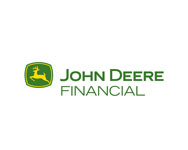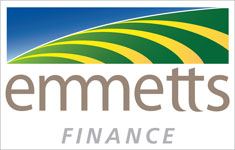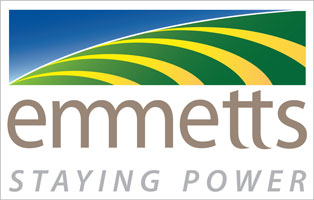
- 16 rows on 762 mm (30 in.) spacing
- Available with optional ExactEmerge™ or MaxEmerge™ 5e row unit or standard in mini-hopper, 1.6 bu., or 3 bu. MaxEmerge™ 5 row unit
- Insecticide option for mini-hopper and 1.6 bu.
- 3-section frame flexes 21 degrees up & down with narrow transport of 3.66 m (12 ft.)
Features
ExactShot™ liquid fertilizer dosing system
NOTE: ExactShot is not available in Australia and New Zealand. Timelines for availability are yet to be determined. The content on the following Sales Manual pages has been compiled for the US/Canada market and therefore may show product information, competitive comparison information, launch dates and marketing and sales activities not relevant for the Australia/New Zealand market. For relevant Australia/New Zealand information, look for New Product Introduction Bulletins published on DealerPath under Tactical Ag Bulletins and What’s New and communicated in the weekly Dealer Newsletters as products become available.
 ExactShot delivers product directly onto the seed in-furrow, eliminating waste between seeds
ExactShot delivers product directly onto the seed in-furrow, eliminating waste between seedsSave on in-furrow fertilizer cost with ExactShot liquid fertilizer dosing system.
High input costs reduce the profitability of any operation. ExactShot can save growers up to 66% of the cost of in-furrow applied nutrients improving their use and efficiency while protecting yield loss along the way. It does this by dosing the product on top of the seed, in the furrow, eliminating the application of product between seeds.
Using less product also results in fewer stops to refill your tanks, improving the overall efficiency of your planting operation.
- Reduce in-furrow fertilizer use up to 66 percent*
- Increase time between starter liquid fertilizer refills in the field
- Maximize nutrient use efficiency by placing product only on the seed
- Enable the potential to add higher-cost or additional applications
*NOTE: Based on internal tests of a prototype ExactShot system performed across 21 farms in six Midwestern states applying a 5.1-cm (2-in) dose on seeds with 15.2-cm (6-in) in-row seed spacing.
How does it work?
When paired with John Deere’s ExactEmerge™ BrushBelt™ technology, the system tracks each seed with infinite accuracy from meter to seed trench, synchronizing each dose with the exact timing of the seed drop. Placing the solenoid directly above the nozzle tip, below the row-unit, adds an additional level of accuracy with each dose not found in similar products.
Two modes of operation
The overall benefits of ExactShot may vary with different products, crop types, soils, etc. In these scenarios, the system can be switched to a more traditional continuous stream of product directly from the display. This gives operators the flexibility to quickly change their application method without the need to change hardware on the planter.
 Dosing mode screen on G5 display
Dosing mode screen on G5 display Continuous mode screen on G5 display
Continuous mode screen on G5 displayAgronomic benefits and savings
Multiple field studies* have shown yields were maintained when the same effective application rate of in-furrow starter fertilizer was dosed directly onto the seed compared to the traditional continuous stream. In some highly responsive instances, as the local rate was increased, yield also increased without adding cost to the application.
By reducing rates, customers can increase their overall profit margins, receiving a higher return on investment with 18.7-L/ha (2-gpa) dosing on-seed compared to 56.1-L/ha (6-gpa) continuous stream. View our ExactShot calculator to see how reduced rates can impact your operation.
Reducing the amount of fertilizer used also reduces the risk of nutrients leaching into nearby rivers, lakes, and ponds.
Additionally, because ExactShot significantly reduces how much product is needed, growers can also gain the ability to use beneficial products in-furrow during planting like biologicals, fungicides, and liquid insecticides that may otherwise be too costly to apply.
*NOTE: Internal tests of a prototype ExactShot system performed across 21 farms in six Midwestern states.
Easy fluid transfer with the ExactRate™ fluid transfer system
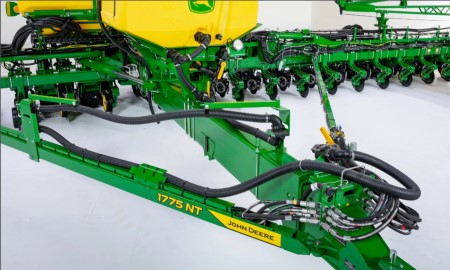 24-row 1775NT Planter equipped with ExactRate system
24-row 1775NT Planter equipped with ExactRate systemThe ExactRate fluid transfer system pairs planters seamlessly with the ExactRate tractor tanks. It provides an easy connection point to allow transfer from the ExactRate tractor tanks back to the planter tank. This enables up 6056 L (1600 gal.)* of combined capacity between the tractor and planter tanks.
- Factory installed
- Designed and tested by John Deere to ensure the lines won’t pinch when folding
- Easily attaches to the ExactRate tractor tanks
ExactRate is available on the following models: 1775NT, 1795, DB44, DB60, and DB66.
*NOTE: 6056 L (1600 gal.) assumes a 2271-L (600-gal.) tank on a 24-Row 1775NT Planter as well as the 3785-L (1000-gal.) capacity on the 8RX Tractor.
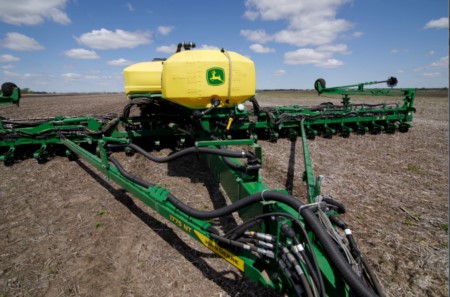 24-row 1775NT Planter equipped with ExactRate fluid transfer system
24-row 1775NT Planter equipped with ExactRate fluid transfer systemEasily carry fluid on the planter with liquid tanks
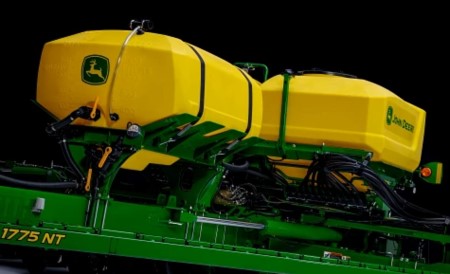 Liquid tank mounted on a 24-row 1775NT Planter
Liquid tank mounted on a 24-row 1775NT PlanterJohn Deere factory-installed liquid tanks offer a convenient way to carry fluid on the planter frame. Styling cues match the CCS™ system tanks, and all brackets and mountings are 100 percent factory installed.
- Factory installed
- Up to 2271 L (600 gal.) of fluid capacity
- Clear sight tube to check fluid level
- Air bleed and overflow protection
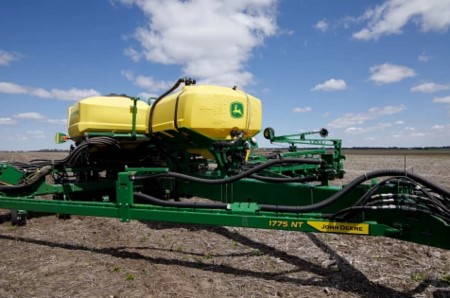 Liquid Tank mounted to a 24-row 1775NT Planter
Liquid Tank mounted to a 24-row 1775NT PlanterDecrease ground pressure with factory-installed tracks for 1775NT Planters
 John Deere factory-installed tracks on a 24-row 1775NT Planter
John Deere factory-installed tracks on a 24-row 1775NT PlanterAlleviate the ground pressure in your center section with John Deere factory-installed tracks. The tracks offer a larger footprint to allow for less compaction and better flotation.
- 91.7-kPa (13.3-psi) ground pressure (based on weight distribution of a fully ballasted 24-row 1775NT Planter over track flat plate area)
- 32.2-km/h (20-mph) transport speed
- Half-full carrying capacity during transport on a 24-row 1775NT Planter
- 100 percent factory installed
NOTE: Factory-installed tracks are only available on the 1775NT Planters.
These factory-installed tracks increase the planter’s flat plate area from 722.6 cm2 to 2683.9 cm2 (112 sq in. to 416 sq in.), which leads to reduced compaction in the planter’s center rows. When paired with the four tracks on the 8RX Tractor, the full solution provides just 103.4 kPa (15 psi) to the ground.
NOTE: Transport duration, carrying capacity, and transport speed assumes the planter is being pulled behind an 8RX with 61-cm (24-in.) belts. See the tractor/planter Operator’s Manual for additional transport restrictions and information.
Tracks are also available as an aftermarket attachment on 1775NT 12-row, 16-row, or 24-row hydraulic drive and electric drive planters.
Key benefits include:
- Reduced compaction in the planter’s center rows
- Better flotation
- Low maintenance, since all joints on the tracks are lubricated for life
- Increased transport speeds (32.2 km/h [20 mph]) and cylinder walking features available when installed on model year 2022 electric drive planters
Compatibility:
- All 1775NT 12-row, 16-row, and 24-row electric drive and variable rate drive machines
- All 1770NT 12-row, 16-row, and 24-row electric drive and variable rate drive machines
- Kits are not compatible with ground drive planters (and/or ground drive attachments)
 24-row 1775NT Planter on tracks being pulled by an 8410RX model
24-row 1775NT Planter on tracks being pulled by an 8410RX modelIncrease visibility at night with light-emitting diode (LED) lighting package
 LED light on stairs to the CCS™ system platform
LED light on stairs to the CCS™ system platformAs planting windows get tighter, many growers are working longer hours to get the seed in the ground. With the planter LED lighting package, John Deere delivers better visibility when planting a night.
- Four additional LED lights
- Improves visibility when planting at night
- Illuminates row-units when servicing at night
- Turns on when tractor lights are engaged
Precise liquid fertilizer placement with ExactRate™ fertilizer system
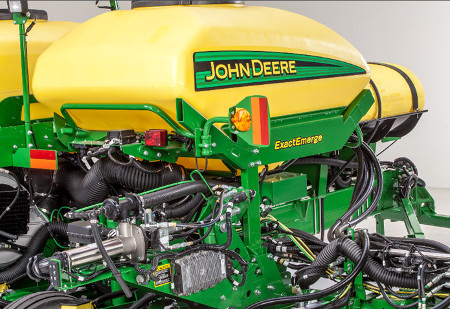 ExactRate pump assembly at rear of 12-row 1775NT
ExactRate pump assembly at rear of 12-row 1775NTThe ExactRate liquid fertilizer system is a factory-installed solution that provides you with accurate nutrient placement during planting. Previously, you would have to deal with the inconvenience of cumbersome aftermarket systems for a hydraulically driven variable-rate solution. With ExactRate, John Deere delivers a complete planting solution for liquid fertilizer users. You can choose between in-furrow or offset delivery methods. A high-rate option without openers is also offered from the factory. This system delivers:
- Up to 20 percent more accurate nutrient placement in a turn compared to a non-turn compensating system
- 1 to 12 percent (4.3 percent on average) reduction in inputs through row-by-row section control
- Ability to run up to 16.1 km/h (10 mph)
- Closed-loop speed and rate change compensation
- Full integration into the G5 Universal Display
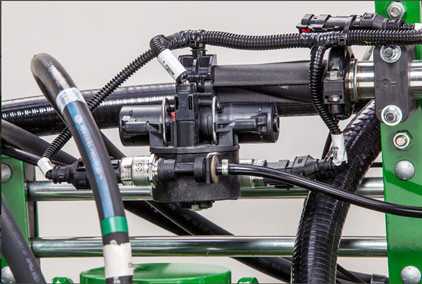 ExactRate nozzle body
ExactRate nozzle bodyThe ExactRate liquid fertilizer system is designed to take full advantage of the capabilities of ExactEmerge™ and MaxEmerge™ 5e planters. This factory-installed liquid fertilizer system delivers the same value as your electric drive planter including working at speeds faster than the traditional 8.05 km/h (5 mph), turn compensation, and row-by-row section control, all while accurately compensating for varying rates and speed changes. Additional features include row-by-row flow detection, as-applied documentation, and variable-rate capabilities.
Fertilizer flows from the tank to the pump, through a strainer and boom isolation valve, through a central flowmeter, and out to each nozzle body and row-unit for accurate delivery. The system is closed loop, meaning the pump and nozzle body duty cycle both adjust based on feedback received from the pressure sensor and central flowmeter. This design helps maintain an accurate application rate.
NOTE: ExactRate is not recommended for products that require agitation to maintain suspension.
Pump
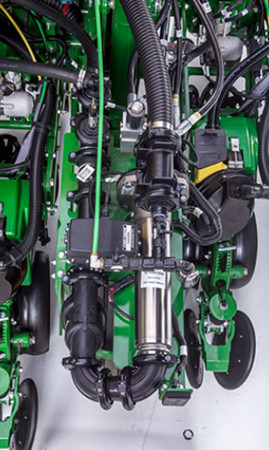 Pump assembly at rear of planter
Pump assembly at rear of planterInstead of a tire-contact drive, a hydraulically driven centrifugal pump eliminates chain and sprocket adjustments to provide more speed flexibility over the entire rate range. This pump allows for a wide range of rate capabilities as well as strong durability. The wet seal design helps protect the pump if it is accidentally run dry for a short time.
Strainer
A strainer helps collect suspended particles and prevent them from causing blockages in the distribution system and nozzle bodies.
Boom isolation valve
The valve prevents the tank from draining out if there is a leak in the distribution system. If the pump is on, the valve opens to allow flow. When the pump is off, the valve closes.
Central flowmeter and pump pressure sensor
The central flowmeter and pump pressure sensor provide the rate control system feedback on flow and pressure to ensure an accurate application rate across the entire planter width. The flowmeter also supplies the as-applied rate data.
Distribution system and nozzle body
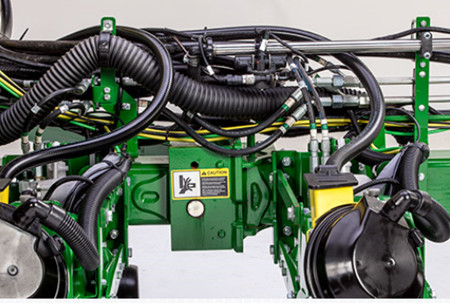 Distribution system and nozzle bodies routed on the wing of a 12-row 1775NT
Distribution system and nozzle bodies routed on the wing of a 12-row 1775NTThe 2.5-cm (1-in.) stainless-steel distribution lines not only reduce corrosion, but they also provide a clean integrated look. The distribution system is pressure tested at the factory to reduce the risk of leaks.
John Deere has leveraged ExactApply™ technology and capabilities from the sprayers to enable row-by-row section control and turn compensation that matches the high-performance planters. With ExactRate, there are no orifice changes for rate or speed adjustments, saving you time and effort while limiting exposure to product. Pulse-width modulation technology varies duty cycle (opening and closing of the valve) in the nozzle bodies in conjunction with flow and pressure measured from central flowmeter and pressure sensor controlling the system pump. The ExactRate liquid fertilizer system uses one nozzle body for two rows, limiting the number of parts and complexity on each machine. While you’re in the cab, you can keep an eye on each row with flow detection integrated into the Gen 5 display. The system warns you if it detects a variance in an individual row’s flow. A pressure sensor integrated into the nozzle body will detect a flow reduction or overapplication on the row.
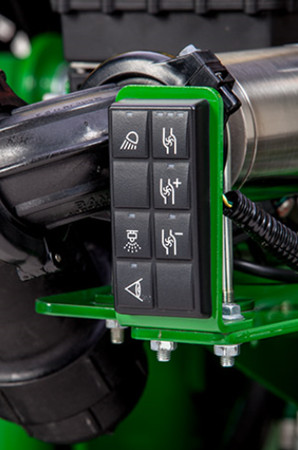 Keypad at rear of planter
Keypad at rear of planterJust like on the sprayers, the keypad at the rear of the machine lets you conveniently perform a nozzle flow check to ensure product is coming out of each row before going to the field.
Rate Controller
The ExactRate liquid fertilizer system is compatible with the John Deere Rate Controller 2000 and GreenStar™ Rate Controller if a producer wants to apply a second product using a separate distribution system.
Direct injection
The ExactRate liquid fertilizer system does not have direct injection capabilities on the product being applied. If direct injection is needed on the secondary product, an additional rate controller is required.
NOTE: ExactRate system and John Deere Rate Controller 2000 with Raven ICD Direct Injection system is supported. ExactRate system and GreenStar Rate Controller with Raven ISO Direct Injection system is not supported.
ExactRate app on G5 Display
Easily adjust target rate and speed without leaving your seat. With turn compensation, inner and outer rates are automatically adjusted to maintain consistent application across the full width of the planter. This ultimately reduces the risk of seed burn by over application (turn compensations require a global positioning system [GPS] receiver). Another helpful feature is row-by-row section control for reduced overlap on headlands and waterways. G5 Documentation creates as-applied maps showing what product was applied where, providing accurate record-keeping.
SeedStar 5 enables new planting technology
 SeedStar 5 screen example
SeedStar 5 screen exampleOverview
SeedStar 5 is the latest monitoring software for John Deere planters available for Model Year 2025. This system is paired with G5 displays and Implement Ethernet to provide high-definition documentation, faster data speeds, and more information in the cab.
Benefits
- Faster data speeds
- High Definition (5Hz data) documentation
- Enables new technology like ExactShot and FurrowVision
- Building block for future planter automation
Additional details
Requirement:
- G5 Display
- Planter Implement Ethernet (included on model year 2025 planters)
- Building block for future planter information
Easy Fold
Easy Fold is a feature of SeedStar™ 4HP for MaxEmerge™ 5e row-units and ExactEmerge™ row-units equipped on 1775NT and 1795 Planters with a 2-point hitch or DB Planters. This integrated solution replaces the frame-folding box like the manual fold option in SeedStar 3 HP, and it has enhanced the process by controlling and automating the selective control valves (SCVs).
The one-operation fold reduces the need for training inexperienced operators by sequencing the process correctly and reduces time spent folding and unfolding. By utilizing implement automation, the hitch will be controlled by the planter during the fold cycle. Lining up the draft tube to the wing hooks is automated through this process, reducing operator tasks. On DB models, Easy Fold simplifies the folding process functions to one SCV. A manual process is available when needed.
A manual fold option is available from the frame control page on the display for non-compatible or non-equipped tractors or planters. The manual control function is accessible from each step of the Easy Fold process, as shown below.
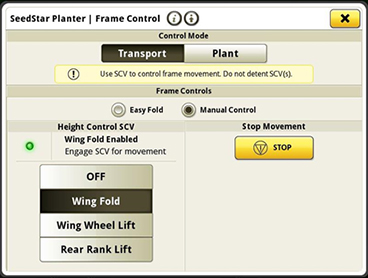 Manual control option on SeedStar 4HP
Manual control option on SeedStar 4HP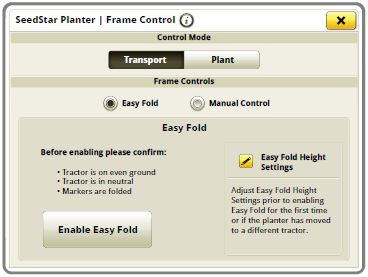 Start screen for Easy Fold
Start screen for Easy Fold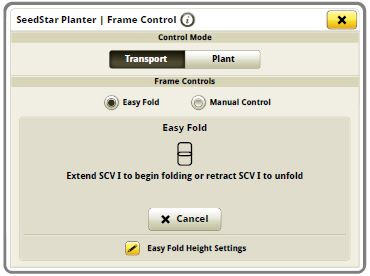 Screen with Easy Fold enabled
Screen with Easy Fold enabled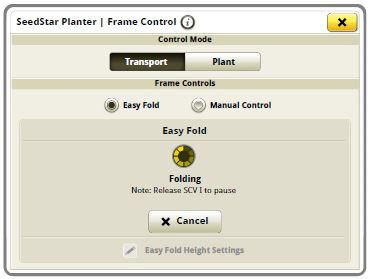 Screen with Easy Fold in process
Screen with Easy Fold in process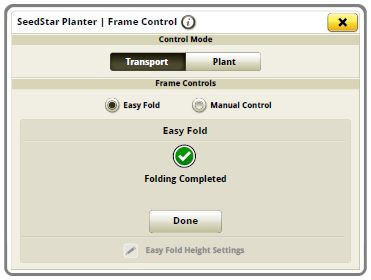 Easy Fold completed screen
Easy Fold completed screen| Easy Fold compatibility | |
| Tractors |
|
| Activation | 2-point hitch equipped planters with Easy Fold require Tractor Implement Automation activation available from the StellarSupport™ portal. This activation is tractor PIN specific and non-transferable. Included in base on model year 2018 compatible tractors. See instructions below. |
| Planters | 1775NT and 1795 with 2-point hitch and DB Planters, equipped with ExactEmerge or MaxEmerge 5e row-units |
| Display | Gen 4 4600 CommandCenter™ Display or 4640 Universal Display |
NOTE: Included in base with ExactEmerge equipped compatible planters. Optional equipment on MaxEmerge 5e equipped compatible planters.
Tractor Implement Automation activation instructions
Use these instructions to download the Tractor Implement Automation activation code at no cost.
- Go to https://www.deere.com/en/stellarsupport/
- Click Product Activation.
- Select Tractor Automation – Manage Product.
- Add or select existing tractor from list.
- Select the Activate button.
- Select Add Manufacturers drop down menu.
- Select Tractor Implement Automation – John Deere.
- Select Continue – Tractor Implement Automation – John Deere selected.
- Accept the Terms and Conditions.
- Select Finish.
- Take note of the code for use display.
- On the Gen 4 4600 CommandCenter Display or 4640 Universal Display select System, Software Manager.
- Select Activations, then Enter Code from John Deere Stellar Support.
- Enter activation code into the display in the tractor.
- Press next after activating Tractor Implement Automation.
- Take note of the activation code and press OK.
- The Tractor Implement Automation activation will appear the Software Manager screen.
NOTE: Prior to the 18.1 software release, the activation will be shown as “Unknown Implement 1” with a baler icon.
YouTube is a trademark of Google LLC.
Mobile row-unit runoff
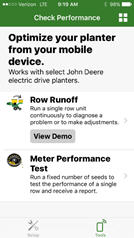 Row Runoff diagnostic test
Row Runoff diagnostic test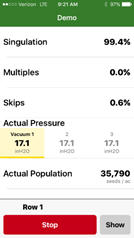 The test functions from a mobile device
The test functions from a mobile device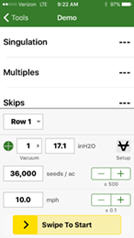 Determine optimum settings without being in the cab
Determine optimum settings without being in the cabThe first day of planting season can be as productive as the last with mobile row-unit runoff. The mobile row-unit runoff activation on the planter main controller (PMC) allows operators to make adjustments to maximize row-unit performance from a mobile device at the rear of the planter for both preseason and in-season use - all enabled through the Equipment Mobile app.
Mobile row-unit runoff allows growers to perform test-stand functions from a mobile device connected to the planter.
The row runoff test provides complete diagnostic checks both preseason and in season. With the row-unit runoff test, the operator can make adjustments from the mobile device, including vacuum pressure, to determine the optimum meter and vacuum settings. This app functionality will help avoid making trips to the cab while validating meter performance.
During preseason planter inspections and set up, utilize the meter performance test to validate meter accuracy, similar to a test stand without leaving the farm. Test all systems on the planter, not just the meter, providing confidence that all planter systems are ready to plant. Reports are generated from the test providing information the operator can save and send for future reference.
Before heading to the field, the operator will benefit from knowing the best row-unit and vacuum settings for each variety selected to plant that spring.
See mobile row-unit runoff in action by watching the "How to Use Mobile Row-Unit Runoff" video.
Mobile row-unit runoff will work with any model year 2015 or newer ExactEmerge™ or MaxEmerge™ 5e equipped planter. Mobile row-unit runoff can be added with attachment AA93169.
For model year 2018 and newer ExactEmerge planters, mobile row-unit runoff is included in base equipment. For model year 2020 and newer MaxEmerge 5e planters, mobile row-unit runoff is included in base equipment. For planters not equipped from the factory, mobile row-unit runoff can be added with attachment AA93169. A mobile row-unit runoff and Easy Fold package can be added with attachment AA97849 (only available with 1775NT and 1795 Planters with a 2-point hitch and model year 2019 and newer DB Planters with Gen 4 based frame folding).
NOTE: Mobile runoff utilizes the Equipment Mobile app available on select iPad® tablets, iPhone® smartphones, and Android™ devices.
Mobile row-unit runoff and Easy Fold aftermarket for field conversion kits
The below software bundles include the functionality explained above for machines not ordered with the feature from the factory. Compatible machines include all the necessary sensors and harnesses needed to make the feature function. The attachment part is software only. Follow the mobile runoff ordering and software push guide below for ordering and installation.
Mobile runoff ordering and software push guide
iPad and iPhone are trademarks of Apple Inc. Android is a trademark of Google LLC.
Downforce system options
Individual Row Hydraulic Downforce (IRHD)
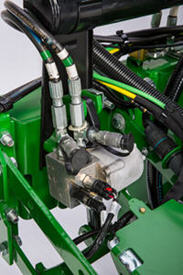 IRHD system
IRHD systemIRHD has been specifically designed to meet the needs of producers that are looking to adjust to the toughest field conditions and provide maximum yield potential from field to field, season after season. IRHD works as a closed-loop downforce system that reacts quickly on an individual row basis to changing soil conditions supporting increased ground contact, which can lead to improved seed depth consistency. When setting planter downforce margin, the system will apply the needed downforce by row to maintain ground contact.
The system allows operators to maintain gauge wheel ground contact leading to desired seed depth placement. IRHD can adjust five times per second and make adjustments of 45.4 kg (100 lb) in less than a second. The system has a total range of applied downforce from 22.7 kg (50 lb) to 204.1 kg (450 lb) and utilizes the power beyond circuit on the tractor. IRHD is 58 percent faster than the active pneumatic downforce solution. Fast reaction and increased ground contact can lead to improved emergence. With uniform emergence, some studies have shown a yield impact from 5 percent to 9 percent.
IRHD is controlled through the G5 Display with SeedStar 5. As shown below, operators can view ground contact or applied downforce using the toggle button.
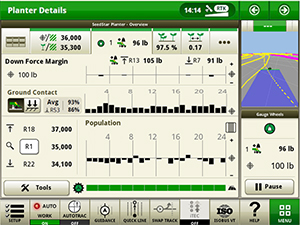 IRHD screen showing the ground contact graph
IRHD screen showing the ground contact graph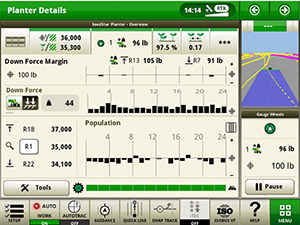 IRHD screen showing the applied downforce graph
IRHD screen showing the applied downforce graphIRHD accumulator
 IRHD accumulator
IRHD accumulatorThe IRHD actuator is the foundation of ensuring accurate seed depth and seed-to-soil contact at higher planting speeds up to 16.1 km/h (10 mph). The newly redesigned IRHD actuator was designed with durability and optimal performance in mind. Consisting of a valve, pressure sensor, cylinder, and now, two accumulators, the new design allows the operator to reduce downtime with recharges instead of replacements. With two rechargeable nitrogen accumulators built into the new IRHD actuator, it maintains performance, even at low nitrogen levels. This allows reduced downtime for the operator, and optimal performance over entire operating range. Pressure control from the IRHD actuator ensures optimal system performance by dampening shocks from field obstacles while operating in the field. The reduction of shock loads prevents excessive wear and broken row unit components due to the new robust and durable design. Frequently worn parts such as the accumulator pistons and seals can be replaced. The actuator rod has an internal retention feature to prevent oil loss in the event of a row unit failure.
Heavy-duty parallel arm for IRHD Planter row units available
 Downforce and margin example
Downforce and margin example- A - Margin – amount of additional downforce applied to a row-unit above and beyond what is required for penetration to achieve planting depth. This additional weight will ride on the depth gauge wheels.
- 54.4 kg (120 lb) + 36.3 kg (80 lb) = 90.7 kg (200 lb) – 68 kg (150 lb) = 22.7 kg (50 lb) of margin
- B - Weight of row-unit - 54.4 kg (120 lb)
- C - Downforce – force that is applied to the row-unit by the air bag circuit - 36.3 kg (80 lb)
- D - Resistance from soil - 68 kg (150 lb)
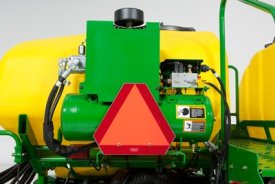 Active downforce compressor assembly
Active downforce compressor assemblyA hydraulically driven compressor works with the G5 Display with SeedStar 5 systems to automate downforce control. Just set the row-unit target margin value and the active pneumatic downforce system works automatically. The system will make sure the planter maintains this value, achieving precise soil penetration, and consistent planting depth, without sidewall soil compaction. From the factory, the system is set at 45.4 kg (100 lb) target downforce margin but may be modified for varying field conditions. This frees the operator from constantly making manual downforce adjustments as conditions change.
This system offers a split-rank control feature for 1795 and DB Split-Row Planters. On split-row planters, active downforce will control the front and rear rows independently. This compensates for differing downforce requirements between the ranks that can be caused by things like different tillage or insecticide attachments and will help maintain an accurate planting depth and consistent margin across all the rows.
Active pneumatic downforce is available as factory installed or as an attachment for field conversion.
Set point row-unit downforce
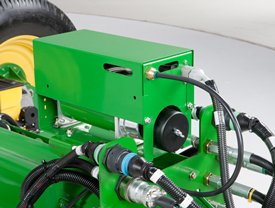 Air compressor mounted on 1775NT outer hitch
Air compressor mounted on 1775NT outer hitchOn set point, the air compressor will be mounted on the outer hitch or frame assembly. Since the electric air compressor assembly is mounted on the outer hitch (as noted in the picture above) or frame, adjustments for row-unit downforce and related system pressures will be made electronically with the display.
When adjusting the amount of row-unit downforce using the display, the operator will select the amount of downforce (kg [lb]) to be applied across the planter. Depending on the soil conditions at hand, the operator might need to adjust the relative amount of row-unit downforce being applied during the planting operation. The integrated pneumatic downforce controls within the display will only allow for set-point operation and not automatic control as the planter is operating in different soil conditions. The pneumatic downforce system does not have the capability to automatically adjust downforce.
Pneumatic downforce provides convenient, simple adjustment of downforce for the whole planter from one location. The amount of downforce applied is infinitely adjustable from 6.8 to 181.4 kg (15 to 400 lb). Pneumatic downforce provides more consistent downforce throughout the range of row-unit travel than mechanical spring downforce systems.
Features include:
- 9.5-mm (3/8-in.) air delivery line instead of the 6.4-mm (1/4-in.) line used on model year 2010 and older planters.
- Air compressor assembly increased duty cycle. With this compressor, it provides a 47 percent increase in maximum air flow delivery compared to the prior air compressor.
- Pneumatic air bags with 9.5-mm (3/8-in.) air line inlets that have greater durability.
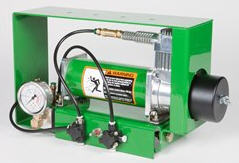 Pneumatic downforce compressor and gauge
Pneumatic downforce compressor and gaugeAn improved compressor is used to charge the pneumatic system. This compressor can be located on the planter frame or in the tractor cab if desired. A gauge at the compressor indicates the amount of downforce being applied.
Integrated pneumatic downforce system
The functional features of the integrated system are the same as the standard pneumatic system, explained above, with the addition of control through the display.
Heavy-duty adjustable downforce springs
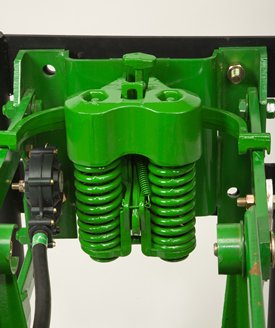 Heavy-duty adjustable downforce spring
Heavy-duty adjustable downforce springPlanter row-unit downforce is an important factor to ensure consistent and proper depth control. The heavy-duty adjustable downforce feature provides up to 181.4 kg (400 lb) of downforce. There are four settings available to allow the operator to choose the amount of downforce required for the condition: 0 kg (0 lb), 56.7 kg (125 lb), 113.4 kg (250 lb), and 181.4 kg (400 lb).
Easy Adjust row cleaners
 Coulter combo row cleaner
Coulter combo row cleaner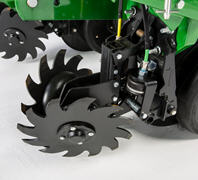 Easy Adjust row cleaner
Easy Adjust row cleanerEasy Adjust row cleaner and coulter combo provides a pneumatic row tillage solution that is controlled from the seat of the tractor.
Every decision to make an adjustment during spring planting reduces the acres planted per day and can increase or decrease profitability. An adjustment that can be overlooked is row cleaners due to planter size, difficulty to make the adjustment, and varying conditions across fields and time.
With the Easy Adjust row cleaners on ExactEmerge™ planters, operators now have a pneumatic solution to make on-the-go adjustments that is controlled directly from the seat of the cab. They can be raised from the cab as needed with the push of a button for wet areas, waterways, or end rows.
The Easy Adjust row cleaners have the capability to save three presets for varying ground engagement based on field conditions. The system is controlled in three sections: at each wing as well as the center (frame or wheel) track rows. The pneumatic lines use air from the active pneumatic downforce compressor, requiring no additional compressor to be installed on the planter. The Easy Adjust row cleaners utilize down and up force air bags. The adjustable air pressure setting for each bag allows the operator to set the ride of the row cleaner depending on the field conditions and the desired results. Making these on-the-go adjustments from tractor cab increases productivity and performance during planting.
For Easy Adjust row cleaner Precision Upgrade options, see the ordering guide.
The row cleaner-only option utilizes parallel linkage to provide the floating action growers require in their fields. Parallel linkage allows for the unit to float up and down in the situation of hills or hard objects. The cleaner and coulter combo does not have parallel linkage, however, the row cleaners have floating rings installed to help provide the same benefits.
The row cleaners utilize the field-proven SharkTooth® design. Row cleaners play a major role in maximizing yield toward uniform emergence, reducing row-unit bounce, and maintaining proper depth. The Easy Adjust row cleaners provide growers with quick and stress-free solutions to customizing the planter in variable field conditions. They are available on most ExactEmerge and MaxEmerge 5e equipped planters.
SharkTooth is a trademark of Yetter Manufacturing Incorporated.
Vacuum automation
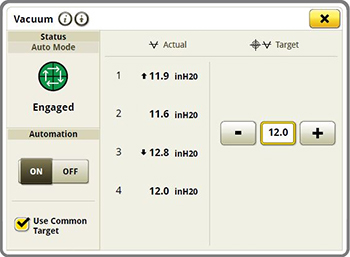 Set-point vacuum screen
Set-point vacuum screenVacuum control has been defined. Before vacuum automation, an operator set the vacuum level by adjusting the hydraulic flow through each selective control valve (SCV). Many variables altered the vacuum level while the hydraulic flow stayed constant. This could have resulted in under or over populating, which may have impacted singulation. With set-point vacuum automation, all that needs to be done is set the desired vacuum level and let the monitor do the work of adjusting the hydraulic flow. Should vacuum changes occur, the software in the monitor will fluctuate the SCV flow to achieve the desired vacuum level.
Set-point vacuum requires SeedStar™ 3 or 4 monitoring. The system controls SCV flow based on the vacuum pressure sensor. The tractor must be a John Deere with Tractor Electronic Control Unit (TECU) 3 controller area network (CAN) system for this feature to be compatible. The set-point vacuum feature will control all vacuum fans if they are on their own SCVs. More vacuum fans make the planter more valuable and easier to operate.
Set-point vacuum is not compatible with Interim Tier 4 (IT4) 6R Series Tractors.
Set-point vacuum works with MaxEmerge™ 5e and ExactEmerge™ planting technologies. It’s available on Deere models as well as select DB models.
RowCommand™ individual-row control system
RowCommand controls seed output
 RowCommand on a MaxEmerge™ 5 row-unit
RowCommand on a MaxEmerge™ 5 row-unit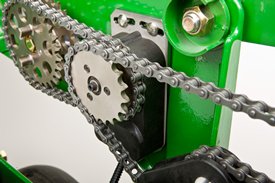 RowCommand on a chain drive MaxEmerge 5 row-unit
RowCommand on a chain drive MaxEmerge 5 row-unitControlling input costs and improving productivity are key producer requirements today. RowCommand is an effective, integrated John Deere solution designed to meet these intensifying needs. The RowCommand system manages seed output, reduces yield drag, and improves harvest capabilities on all Pro-Shaft™ driven row-units, and chain-driven MaxEmerge 5.
NOTE: Chain-drive RowCommand is only compatible with planters equipped with pneumatic downforce systems. On planters equipped with the heavy-duty downforce springs, potential chain interference may result and is not recommended.
NOTE: Chain-drive RowCommand requires some modification to brackets in order to function with corn finger pickup meters.
NOTE: Pro-Shaft drive RowCommand is compatible on MaxEmerge 5 row-units with vacuum and corn finger pickup meters. For mini-hopper row-units, RowCommand is compatible on vacuum meters only and is not compatible on corn finger pickup meters. Pro-Series™ XP row-units with corn finger pickup meters are not compatible with RowCommand.
RowCommand controls seed output by incorporating individual, low amperage clutches inside the Pro-Shaft and chain-driven gearboxes. Clutches are completely enclosed within the gearbox housing to protect them from the elements and harsh operating conditions.
When power is supplied, either manually or through John Deere Section Control software, clutches disengage the seed meters and seed flow stops. Controlling seed output at individual rows reduces overplanting in point rows and maximizes seed placement when entering/exiting headlands.
Components and operation
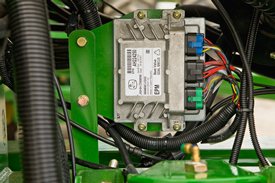 Electronic power modules shown on a 1775NT Planter
Electronic power modules shown on a 1775NT Planter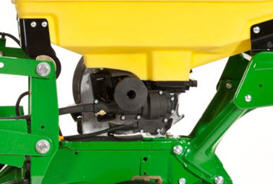 RowCommand clutch on MaxEmerge 5 with 105.7-L (3-bu) hopper
RowCommand clutch on MaxEmerge 5 with 105.7-L (3-bu) hopperRowCommand is a simple and efficient solution to control individual row planting. This system does not utilize air to operate; therefore, no compressor, air lines, or valve modules are required.
RowCommand utilizes low-voltage controller area network (CAN) messaging to signal power to the desired clutches to stop planting or eliminates power to resume planting.
This means very little power is used in normal planting conditions, and in the event a clutch fails electrically, the meter will continue to plant.
The RowCommand system requires the following five basic components to operate:
- Electric clutches
- Electronic power modules (EPMs)
- SeedStar™ 2 or XP monitoring (wedge box/controller)
- GreenStar™ display
- Planter wiring harnesses
Clutches are protected within the sealed Pro-Shaft and chain-driven gearboxes for years of trouble-free operation and simple installation or removal. RowCommand has true individual-row control of up to 16 clutches or sections for planters larger than 16 rows.
Unique to RowCommand, the 16 available control sections can be configured based on operator preferences. For example, on a 1775NT 24-Row Planter, every two rows can be paired together for a total of 12 control sections or control the outermost eight rows individually and the remaining inner rows paired together for 16 control sections.
While SeedStar with RowCommand has 16 control sections, a minimum of 152.4-cm (60-in.) wide sections are recommended for optimum Swath Control Pro™ solution capabilities. As with other Swath Control Pro products, an SF2 signal is the minimum level of accuracy recommend for operation.
Chain-drive RowCommand and heavy-duty downforce
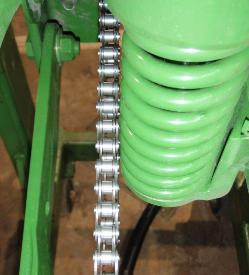 Chain interference with heavy-duty downforce
Chain interference with heavy-duty downforceAs seen in the image, chain interference may result when operating chain-drive RowCommand on planters equipped with short and long parallel arms and heavy-duty downforce springs.
NOTE: Chain-drive RowCommand is only compatible with planters equipped with pneumatic downforce systems. On planters equipped with the heavy-duty downforce springs, potential chain interference may result and is not recommended.
Chain-drive RowCommand with corn finger pickup meters
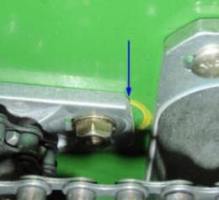 Bracket material removal
Bracket material removalDue to the design characteristics of the chain-drive RowCommand clutch, some modification to the corn finger pickup meter drive bracket is required. As seen in the image above, some material needs to be removed from the front of the meter drive bracket in order for the chain-drive RowCommand clutch to have sufficient space for installation.
NOTE: Chain-drive RowCommand requires some modification to brackets in order to function with corn finger pickup meters.
RowCommand ordering information
To add RowCommand to a model year 2009 and newer planter model listed above is simple. Pro-Shaft drive attachments for field conversion and chain-drive attachments for field conversion are available by planter model to add the appropriate number of clutches, EPMs, brackets, hardware and row-unit harnesses. For complete installation and part detail for the RowCommand conversion, please use the RowCommand compatibility tool per specific planter model.
RowCommand is compatible and available for model year 2003 (serial number 700101) to 2008 (725101) planter models listed above. In addition to the attachment for field conversion attachment, a planter mainframe harness, SeedStar 2 controller (wedge box), and additional CAN harnesses are needed.
Integrated Section Control
Coupling RowCommand with Section Control provides the ultimate in precision planting and productivity. One company and one integrated solution are what John Deere offers by incorporating Section Control capabilities within the SeedStar 2 wedge box (controller). Unlike previous systems, no rate controller, additional harnessing, or components are required to achieve automated individual-row control.
SeedStar 2 and XP monitoring, RowCommand, and Section Control activation from John Deere Precision Ag Technologies are all that is needed when ordering.
System requirements
RowCommand is a simple and efficient means to control individual row planting using low-voltage electric clutches. When activated, each clutch consumes no more than 0.5 amps. By design, power is only supplied to the clutch when a signal is received to stop planting. In a normal planting condition, no power is supplied, and the clutch is de-energized.
Power for the RowCommand system is provided from the nine-pin ISO implement connector. All late-model 8X00 and 9X00 Series and newer John Deere Tractors equipped with the nine-pin ISO implement connector can supply ample power for system operation.
Along with ample system power, a GreenStar display and SeedStar monitoring are required for operation and control interface. The GreenStar display is where system setup, control settings, and manual control functions are performed.
Seed variable-rate drive (VRD) with half- or three-width disconnect
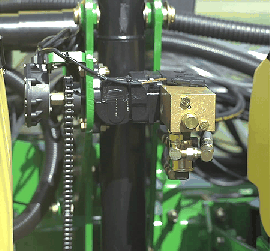 VRD shown on a 1775NT
VRD shown on a 1775NTThe seed variable-rate drive provides the ultimate planting productivity by utilizing one, two or three hydraulic motors (varies by model) to turn the seeding drive shaft. Hydraulic control of the seeding drive allows for on-the-go seeding rate changes right from the display mounted inside the tractor cab.
Combine this seeding flexibility with the map-based planting option, and seeding rates adjust automatically based on a prescription map.
Single- or dual-motor systems for variable-rate drives are available for all John Deere planters except the 1785 Rigid Frame. Dual- or three-motor drive systems are commonly used on larger (12-row and more) planters and offer the capability of half-width or three-section drive disconnect.
The VRD is available as a factory-installed option for all applicable planter models. Single- or dual-motor systems are available as field-installed attachments for most planter models; however, a three-motor VRD field-installed attachment is not available.
The seed VRD requires the SeedStar™ monitor and a radar input signal. Either tractor or planter radar may be used. Planter radar is ordered separately.
VRD offers the following advantages over common, contact-tire drive systems:
- Almost instantaneous rate changes – there is no ramp up or ramp down of system as in some competitive systems
- Permits the operator to match seed population based on different soil types or irrigation practices
- John Deere design that provides added operator safety by eliminating any possible drive creep found in some competitive variable rate drive systems
Half-width drive disconnect
The half-width drive disconnect feature is excellent for the producer concerned with controlling seed costs. This feature helps the operator place seed in the desired area and limit the amount of costly overlapped planting.
The half-width drive disconnect allows the operator to turn off half of the planter at a time for planting end rows, point rows, etc. Variable-rate-equipped planters require two drive motors to utilize the half-width disconnect feature.
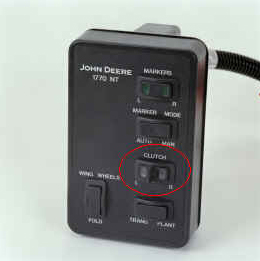 Half-width drive disconnect within frame control
Half-width drive disconnect within frame controlWith a 1765, 1765NT, and 1775 12-Row Planter, a single switch box is required for planters that are ordered with variable rate drive and half-width disconnect.
For the 1775NT, 1775NT Central Commodity System (CCS™), and 1795 Front-Folding Planters, the half-width drive disconnect switch is contained within the frame control box, conveniently located in the tractor cab. The function easily shuts off the drive for the left or right half of the planter row-unit seed meters.
Three-width drive disconnect
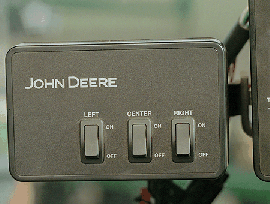 Three-width drive disconnect control
Three-width drive disconnect controlThree-width drive disconnect is an option on 1725 12-Row Planters and is base equipment on the 1725 16Row30 Planter. This feature is activated by three individual console mounted switches (control box), conveniently located in the tractor cab. The function easily shuts off the planter row-unit seed meters by one-, two-, or three-drive segments independently.
Row cleaner options to meet residue management needs
Crop yields have increased through the years along with the amount of residue left in the field after harvest. At the same time, tillage practices have changed, including different tillage operations which maintain large amounts of surface residue, and even no-till practices. Row cleaners are an essential tool in managing this increased amount of residue.
John Deere seeding group offers a variety of row cleaner options to meet the needs of a producer's operation. Compatibility varies by model, row spacing, and other planter equipment.
Screw-adjust, unit-mounted row cleaner
 Screw-adjust, unit-mounted row cleaner
Screw-adjust, unit-mounted row cleanerThe screw-adjust, unit-mounted row cleaner is mounted directly to the face plate of the row-unit, placing the ground engaging components just in front of the row-unit opener blades and depth gauge wheels. This close proximity allows the gauge wheels to control the depth of the row cleaner as well as the row-unit. This compact design also allows greater compatibility with fertilizer openers and other planter attachments.
SharkTooth® wheels are standard equipment on the unit-mounted row cleaner. The swept-tooth design of the wheel provides a clear path for the row-unit openers while resisting residue buildup on the wheel. The screw adjustment knob is accessible through the top of the parallel arms, providing convenient access for adjustments. The row cleaner can be adjusted in 1.6-mm (1/16-in.) increments, providing plenty of flexibility to meet the needs of changing conditions.
Floating row cleaner with unit-mounted coulter
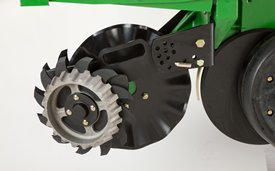 Floating row cleaner with unit-mounted coulter
Floating row cleaner with unit-mounted coulterThe floating row cleaner allows a row cleaner to be used in conjunction with a unit-mounted coulter. This combination is often desired in heavy residue loads and reduced tillage planting conditions. The row cleaner provides a clear path for the row-unit, while the unit-mounted coulter helps penetrate tough soil conditions.
Accommodating the unit-mounted coulter means the residue wheels are farther forward from the row-unit face plate than in the case of the screw-adjust row cleaner. To maintain performance, this row cleaner has the capability to float above a defined minimum depth.
Standard depth-gauging bands on the wheels allow the row cleaner wheels to float independently of the row-unit openers, allowing both to perform in varying terrain. The unit may also be set in a fixed position by simply pinning through the bracket if desired. This row cleaner also features SharkTooth wheels as standard equipment.
The floating row cleaner and unit-mounted coulters are available on many planters as factory-installed equipment.
NOTE: Screw-adjust row cleaners are not compatible with MaxEmerge™ 5e row-units with long parallel arms.
NOTE: DB models have the option for either unit-mounted coulter, screw-adjust row cleaners, or pneumatic row cleaners (only compatible with MaxEmerge 5e or equipped ExactEmerge™ models). The DB60T is only available with a less row cleaner option.
SharkTooth is a trademark of Yetter Manufacturing, Inc.
Increase productivity with ExactEmerge™ trench delivery system and BrushBelt™ delivery system
It is very challenging to get the crop planted during the optimum planting window or as close to the optimum planting day as possible. Rate-of-yield loss accelerates greatly after the optimum window has passed. This is especially true in the northern U.S. and Canada. ExactEmerge maintains accurate speed placement at higher speeds; growers can avoid missing that peak planting time, thereby helping to get the highest crop yields.
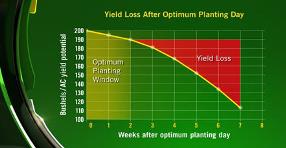 Yield loss after optimum planting day
Yield loss after optimum planting dayWith the BrushBelt trench delivery system, the spacing in the trench does not change from even to uneven terrain. This can be a problem with a traditional seed tube. Seed bounce and ricochet may occur as slopes increases, ultimately decreasing seed spacing performance.
The design of the BrushBelt system provides the best solution for the lowest release of seed to the bottom of the trench. The use of a brush provides the meter with an infinite amount of placement opportunities for each seed. This is what gives producers the confidence that every seed will have the desired spacing that a seed tube cannot provide.
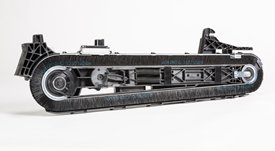 Maintenance-free BrushBelt system
Maintenance-free BrushBelt systemWhen the brush comes around the pulley, it expands and allows the seed to be transferred from the bowl to the brush very easily. The brush then carries the seed down toward the trench, ensuring that there is no movement as it moves down the length of the cartridge.
Once the brush reaches the lower pulley, the BrushBelt system expands again to loosen the grip on the seed, and the centrifugal force releases the seed. Another advantage with the BrushBelt system and cartridge at all speeds up to 16.1 km/p (10 mph) is the ability to match the seed rearward trajectory to the forward ground speed of the planter. This provides a dead drop of the seed with no bounce and no roll at the bottom of the trench.
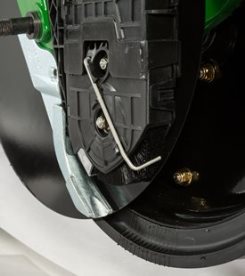 BrushBelt conditioner engages brush bristles
BrushBelt conditioner engages brush bristlesJohn Deere’s ExactEmerge cartridge is self-cleaning. When an operator uses seed treatments or is forced to plant in less than ideal soil conditions, the design of the trench delivery system sheds buildup from the BrushBelt. A brush conditioner is located at the bottom of the cartridge to remove remaining residue and prevent the bristles from sticking together.
 Brush proximity helps clean sensor
Brush proximity helps clean sensorAnother advantage over a seed tube is that the BrushBelt system also acts as a cleaner to the seed sensor compared to a seed tube.
 Sensors for trench delivery system
Sensors for trench delivery system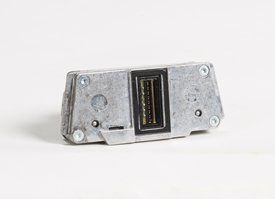 Reflective seed sensor
Reflective seed sensor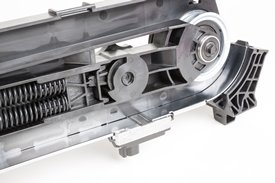 Sensor on trench delivery system
Sensor on trench delivery systemOn all ExactEmerge row-units, each cartridge is equipped with sensors. As the seeds are being delivered through the BrushBelt delivery system controls, they pass the reflective seed sensor. The delivery system slides every seed past the seed sensor to read and send the signal to the controller. The seed sensor and design can provide sensor performance at higher seeds per second with no population adjustment as needed with seed tube sensors. This seed sensor data is actual row-unit performance data. In comparison, seed tube sensors add 10 percent population in soybean planting to adjust for the seeds missed due to placement within the seed tube. The BrushBelt system holds each seed in place until released in the trench, allowing the seed sensor a more accurate read.
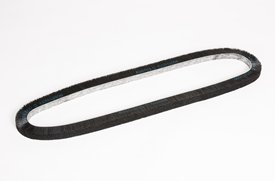 BrushBelt removed from trench delivery system
BrushBelt removed from trench delivery systemThe BrushBelt system requires no maintenance and has a wear life designed to match the wear life of the other wear components. Since operations vary, as do soils and field content, it is recommended to replace the BrushBelt after noticeable wear or decreased performance.
Changing the belt is easy. One latch removes the meter over the trench delivery system. Grab the cartridge by the grip and pull toward the body, releasing it from the electric motor fitting. Lift the trench delivery system up and remove the sensor wiring harness to completely pull the cartridge out of the row-unit.
There are two plastic covers that snap off to uncover the belt; remove the covers and then twist the circular spring tensioner dial with the yellow arrow on it to release the tension on the springs. Once tension has been removed, pull the belt out. It is also recommended to change the stainless-steel wear strip at this time as well, which also slides right out of place without the use of tools.
NOTE: It is recommended to use a talc/graphite mixture with ExactEmerge. Best results have been 80 percent talc and 20 percent graphite. For certain regions and territories, talc and talc/graphite mixes are restricted from use; in this case, use a wax-based fluency agent.
Dual 56-V electric motors for ExactEmerge™ row-units
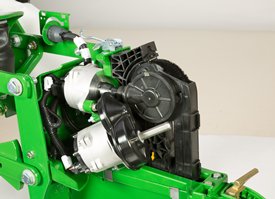 Two 56-V brushless electric motors
Two 56-V brushless electric motors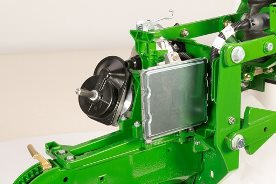 Improve productivity with two 56-V brushless electric motors
Improve productivity with two 56-V brushless electric motorsTwo 56-V brushless electric motors provide ExactEmerge the upper hand over any other row-unit on the market. One motor controls the high-performance meter and the other powers the BrushBelt™ delivery system. Both feature a closed loop system ensuring they operate at the correct rpm.
The motor is controlled at a rate of 200 times per second and a decision is made every 5 milliseconds. The controller also keeps each motor operating at independent speeds of each other. The meter speed is determined by a combination of ground speed and desired population rate while the BrushBelt speed stays consistent with the forward ground speed of the planter in order to place the seed at the bottom of trench.
 Brushless motors are maintenance free
Brushless motors are maintenance freeIndustry-proven 56-V brushless motors give confidence to the operator that the row-unit will perform in any condition. The advantage of 56-V over 24-V electric motors is a lower amperage draw.
Brushless motors are maintenance free and give the producer the most optimal solution to achieve the highest performance and the lowest amount of work to the planter.
 Built-in RowCommand™ system
Built-in RowCommand™ systemManage seed output, reduce yield drag, and improve harvest capabilities are features built in to every ExactEmerge row-unit with electric motor shutoffs.
The electric drive version of RowCommand row-unit has the potential to get 2 to 8 percent reduction in seed usage from being able to control the meter and BrushBelt rather than a clutch disengaging and some seeds still falling down the seed tube.
SeedStar™ XP monitoring system
SeedStar XP overview
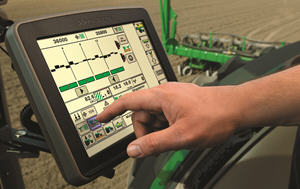 SeedStar XP shown on the GreenStar™ 3 2630 Display
SeedStar XP shown on the GreenStar™ 3 2630 Display SeedStar XP shown on the GreenStar 2 1800 Display
SeedStar XP shown on the GreenStar 2 1800 DisplayBuilding upon the foundation of SeedStar 2, the SeedStar XP system takes planter monitoring to the next level. Specific information about how the planter is performing enables the operator to make needed adjustments for implement optimization.
SeedStar XP is compatible with:
- GreenStar 2 1800 Display
- GreenStar 2600 Display
- GreenStar 3 2630 Display
- Gen 4 4200 CommandCenter™ Display
- Gen 4 4600 CommandCenter Display
- 4240 Universal Display
- 4640 Universal Display
- G5 Integrated and Universal Display
- G5Plus Integrated and Universal Display
- G5e (Ground Drive only)
SeedStar XP is not compatible with the Gen 4 Extended Monitor or G5 Extended Display.
The SeedStar XP planting functions are fully integrated with the full spectrum of Precision Ag Technology applications such as Swath Control Pro™ system for planters, Section Control, GreenStar AutoTrac™ assisted steering system, John Deere Operations Center, Documentation, and others. Integrated planting technologies for better asset utilization and ease of use is just part of what SeedStar XP provides.
SeedStar XP seed singulation monitoring
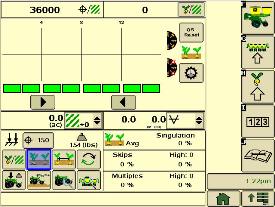 SeedStar XP seed singulation planter run page
SeedStar XP seed singulation planter run pageUnderstanding the meter singulation performance on the planter is critical to minimizing the amount of seed multiples and skips. As a result, the SeedStar XP monitoring system provides real-time information from the row-units about the overall seed singulation performance.
As seen in the screen shot image above, seed multiple information is displayed on the top portion of the planter-at-a-glance bar with seed skip information on the lower portion. This provides the operator a better understanding of relative seed multiple and skip data on a row-unit basis, all within one easy glance.
Also, within the seed singulation planter run page, information about row-units with the highest percentage of seed multiples and skips is provided in order to make necessary adjustments for better planter optimization.
SeedStar XP row-unit ride dynamics planter run page
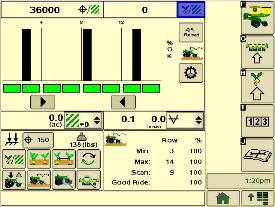 SeedStar XP ride dynamics planter run page
SeedStar XP ride dynamics planter run pageWhile operating a planter, travel speed and field conditions can affect the amount of row-unit bounce that is experienced. Excessive row-unit bounce or vertical motion can cause problems with meter performance. To better understand the amount of row-unit vertical motion when travelling through a field, the SeedStar XP monitoring system provides real-time information on row-unit ride dynamics.
As seen in the ride dynamics planter-at-a-glance screen shot image above, the SeedStar XP system provides ride dynamic information for each sensor node that is mounted on the planter. Each sensor node transmits ride dynamic information for each planter frame section to allow for the operator to make necessary operating adjustments to improve overall planting performance.
SeedStar XP row-unit downforce planter run page
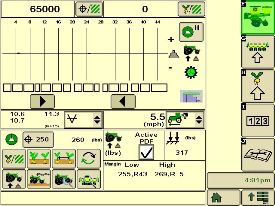 SeedStar XP downforce planter run page
SeedStar XP downforce planter run pageAs row-unit downforce systems gradually change from heavy-duty downforce springs to pneumatic downforce, being able to understand the amount of as-applied row-unit downforce is needed while operating the planter.
With various soil conditions, moisture, etc. experienced while planting, it is imperative to have the ability to change actual row-unit downforce to have enough force for the Tru-Vee openers to penetrate the soil media. However, in some conditions, having too much downforce applied to the row-units for effective opener penetration could cause problems with side wall compaction from the gauge wheel.
Side wall compaction within the seed furrow can cause hatchet roots to develop, or roots that do not have the ability to penetrate the seed furrow soil media. This could lead to poor plant emergence and eventually lower overall yield performance.
With the SeedStar XP monitoring system, row-unit downforce information is measured by the downforce sensor and sensor nodes and transmitted to display in the tractor cab (as seen in the image above). The row-unit downforce information is displayed on the top portion of the planter-at-a-glance bar with more row-unit downforce information on the lower portion.
Two different control options are available on 1775NT, 1795, and DB Series Planters for pneumatic downforce. The base pneumatic downforce system requires manual control of the downforce to maintain the desired planting results or row-unit margin. Optional active pneumatic downforce takes SeedStar XP even further by removing constant downforce adjustments from the operator and actively controlling the downforce system to maintain a desired target margin.
The 1745 Planter with pneumatic downforce and SeedStar XP will require manual control of the downforce to maintain row-unit margin.
SeedStar XP seed spacing monitoring
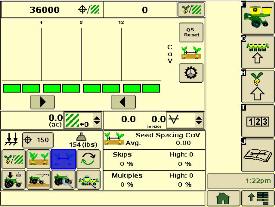 SeedStar XP seed spacing planter run page
SeedStar XP seed spacing planter run pageThroughout the planting process, obtaining good seed spacing is critical toward achieving plant growing conditions for maximum yield potential.
Today, many items are adjusted on the planter prior to planting to optimize overall seed spacing performance. After such adjustments are made, information about the actual seed spacing performance during planting was missing within the planter monitoring system. With SeedStar XP, seed spacing information is transmitted live via the GreenStar display to show the operator exactly what is happening with the planter behind them.
The SeedStar XP transmits seed spacing information onto the planter-at-a-glance bar for easy understanding of planter seed spacing performance. Also, information about seed skips and multiples is provided to help understand actual planter meter performance and other related system functions in order to make necessary adjustments if needed.
NOTE: Seed spacing and seed singulation information is only available when planting crops with seed drop rates below 40 seeds per second such as corn. With higher population crops such as soybeans the system does not provide spacing and singulation information because the number of seeds dropping per second is much higher.
SeedStar XP full planter performance page
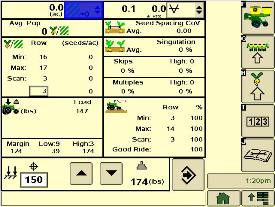 SeedStar XP planter details
SeedStar XP planter details With the capability of monitoring differences in planting performance items such as seed singulation and row-unit downforce, having one screen to view all planter performance elements is needed to understand the whole planting system. SeedStar XP combines all of the various planting performance elements into one full-color, planter overview screen to enable for a quick understanding of relative planting functionality.
SeedStar XP half screens and other features
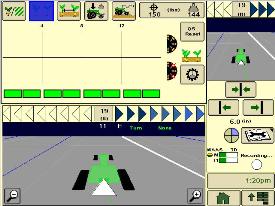 SeedStar XP seed singulation half screen
SeedStar XP seed singulation half screen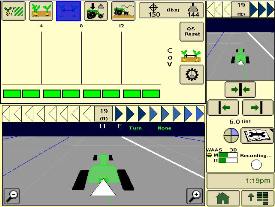 SeedStar XP seed spacing half screen
SeedStar XP seed spacing half screenOther SeedStar XP monitoring features include:
- Capable of monitoring individual row-unit and overall planter performance in terms of seed spacing, singulation, and row-unit downforce
- Split-screen applications to enable use of popular guidance features such as AutoTrac assisted steering system
- On-screen indication of sensor node/downforce sensor assemblies once configured within the monitor settings application
- Full-color display icons for easy recognition and overall aesthetics
- Pneumatic downforce system controls with the GreenStar display application
SeedStar 2 monitoring original features
SeedStar XP retains all of those SeedStar 2 features that producers value and have come to expect:
- Planter-at-a-glance – allows operator to view relative population levels of all rows on one screen.
- Automatic valve calibration – with the SeedStar variable-rate drive (VRD), this is completed automatically. There is no longer a need to manually calibrate the hydraulic valves.
- Increased population updates – SeedStar will update population levels once per second at planter start up then approximately once every three seconds.
- Mapping of actual seed rates – when combined with documentation, actual and target seeding rates can be mapped in John Deere Operations Center.
- Reprogrammable utilizing controller area network (CAN) via Service ADVISOR™ diagnostics system.
- Improved diagnostics/event recorder – on SeedStar VRD planters, additional diagnostic information is available, as well as an event recorder to capture system performance data at a specific point in time.
- Ability to run motors at different population levels – on SeedStar VRD, operators running multiple motor systems can run each motor at a different speed, allowing different population levels within a planter.
- User-configurable high fertilizer pressure alarm – allows the operator to be warned when fertilizer pressure reaches a specific level.
- Automatic quick-start for SeedStar VRD – no longer does the operator need to press the quick-start button on end row turns to resume planting.
- Automatic tractor speed source selection – when equipped with an 8000/9000 Series Tractor, the system selects the radar speed or allows for manual speed input selection.
Components and operation
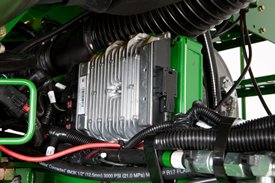 Planter main 2 controller
Planter main 2 controller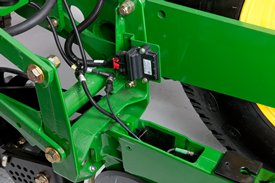 Sensor node assembly installed
Sensor node assembly installedThe SeedStar XP monitoring system contains the following components in order to support the planting data transfer to the GreenStar 2 Displays:
- Seed monitor/variable-rate (SMVR) controller with model year 2011 or newer software
- Planter main 2 controller (installed on all SeedStar XP eligible models for model year 2011 or newer)
- Sensor node(s)
- Downforce sensor assembly
The planter main 2 controller processes the row-unit data from the sensor node assemblies located on the row-unit head casting. The processed information is then sent to the SMVR controller to be integrated into the displayed information being sent to the GreenStar Display.
Downforce sensor assemblies are found on row-units with sensor nodes installed. The downforce sensor assembly is assembled with the gauge wheel depth-adjustment handle and provides gauge wheel pressure information to the respective sensor node for data processing.
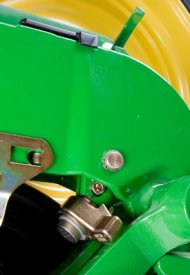 Downforce sensor installed
Downforce sensor installed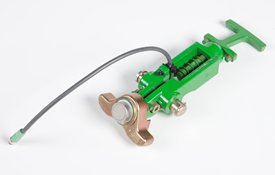 Downforce sensor assembly
Downforce sensor assemblyDepending on the planter size, different configurations of sensor nodes and downforce sensors are installed in support of the SeedStar XP monitoring system.
Specifications
Key Specs
- Number of rows
- 16
- Row spacing
- 76 cm
30 in.
- Frame - Fold configuration
- Frame - Flexibility
- Up and down: 21 degree (angle)
- Row unit seed hoppers
- Capacity
2.2 L (0.062 bu)
58 L (1.65 bu)
106 L (3.0 bu)
- Seed Meters
- Base
Vacuum
Finger pickup
Optional
Rows And Row Spacing
- Number of rows
- 16
- Row spacing
- 76 cm
30 in.
Frame
- Fold configuration
- Frame tube size
- Fold-and-go from tractor cab
- Flexibility
- Up and down: 21 degree (angle)
Hitch
- Base
- Optional
- Rear hitch
Lift System
- Type
- Wheel modules with hydraulic cylinders
- Number of cylinders
Tires
- Base
- Implement tire: VF245/70R19.5
- Optional
- Factory-installed Soucy tracks
- Quantity
Row Units
- Type
- Standard: MaxEmerge™ 5 row units
Optional: ExactEmerge™ row units
MaxEmerge 5e row units
- Opener
- Tru-Vee double disk
- Depth gauging
- Adjustment
- Walking wheels
- Row unit seed hoppers
- Capacity
2.2 L (0.062 bu)
58 L (1.65 bu)
106 L (3.0 bu)
- Row unit down force
- Scrapers, opener blades
- Seed tube sensors
Seed Meters
- Base
- Vacuum
- Optional
- Finger pickup
- Optional
- Radial bean meter
- Optional
- Central Commodity System
- Seed capacity
4581 L
130 bu
Drive System
- Base
- Hydraulic variable rate drive
- Optional
- Number of drive wheels
- Drive wheel disconnect
- Counter shaft
- Drill shaft
- Seed transmission
- Transmission combinations
Markers
- Type
- Automatic alternating or independent control
- Control
- Marker disk
- Shear bolt protection
- Less marker option
Closing System
- Rubber tire closing system
- Cast iron closing system
Herbicide And Insecticide
- Insecticide only hopper
- Herbicide only hopper
- Insecticide and herbicide hopper
Liquid Insecticide System
- System available
- Tank capacity
Seed Monitor System
- Base
- Optional
Tillage Attachments
- Unit-mounted coulter
- Frame-mounted coulter
- Bubble blade
- .63-in. fluted blade (25 flutes)
- .7-in. fluted blade (13 flutes)
- 1-in. fluted blade (8 flutes)
- Row tillage support hanger
- Tine tooth
- Cons. furrower w/ leading cutout blade
- V-wing bed sweeps
- Row cleaner
- Row cleaner - unit-mounted coulter
- Row cleaner - unit-mounted DD fert. opener
Fertilizer
- Onboard / towed / tractor tanks
- Tank capacity
- 1703 L
450 gal.
- Fixed-rate application
- Variable-rate application
- Pump type
- Pump rate
- Fertilizer opener type
- Flow divider distribution system
- Pressure manifold distribution system
- Dry fertilizer
- ExactRate Fluid Transfer System
- Available
Dimensions
- Transport width (with markers)
- 3494 mm
137.56 in.
- Transport width (without markers)
- Transport length
- 10193 mm
401.3 in.
- Transport height
- 3800 mm
149.6 in.
- Transport weight
- Transport underframe clearance
- Field operation height
- Field operation width
- 12870 mm
506.7 in.
- Field operation length
- 6533 mm
257.2 in.
Ag Management Solutions
- Map-based seeding
- Field documentation
- Parallel tracking
Additional Information
- Recommended tractor horsepower
- Minimum tractor size required: 90 kW
120 PTO hp
Operating with extra planter attachments or when planting in soft seedbeds and rolling ground, more tractor power is required.
- Recommended tractor hydraulics
- Hydraulic oil required to operate machine: 5.7 L
1.5 gal.
Hydraulic system working pressure: 20,684 kPa
206.84 bar (3000 psi)
Hydraulic system burst pressure: 82,737 kPa
827.37 bar (12,000 psi)
Tractor standby pressure: 15,514 kPa
155.14 bar (2250 psi)
- Warranty length
- Date collected
